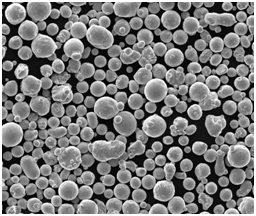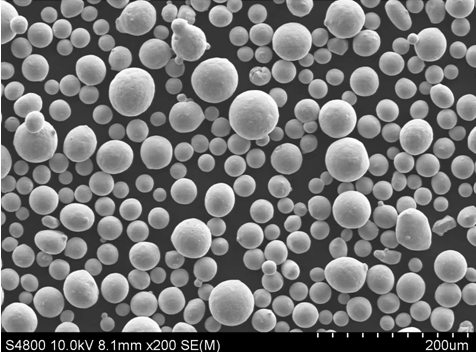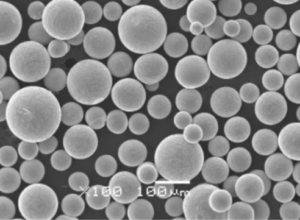Overview
High thermal conductivity alloys are crucial in various industries, thanks to their ability to efficiently transfer heat. These alloys are engineered to handle extreme temperatures and facilitate heat dissipation in applications ranging from electronics to aerospace. But what makes these alloys so special? Let’s dive into the specifics of high thermal conductivity alloys, their compositions, properties, and uses.
Composition of High Thermal Conductivity Alloys
The magic of high thermal conductivity alloys lies in their composition. Various metal powders are blended to achieve the desired thermal performance. Here’s a breakdown of some specific metal powder models and their unique properties:
| Metal Powder Model | Composition | Thermal Conductivity (W/m·K) | Key Properties |
|---|---|---|---|
| Copper (Cu) | Pure Copper | 398 | Excellent conductivity, malleability |
| Aluminum (Al) | Pure Aluminum | 235 | Lightweight, corrosion-resistant |
| Silver (Ag) | Pure Silver | 429 | Highest conductivity, antimicrobial properties |
| Gold (Au) | Pure Gold | 318 | Excellent resistance to corrosion and oxidation |
| Graphite (C) | Carbon | 150-500 | High thermal and electrical conductivity, lubricity |
| Silicon Carbide (SiC) | SiC | 120-270 | High hardness, chemical stability |
| Beryllium Oxide (BeO) | BeO | 250 | High thermal conductivity, electrical insulation |
| Diamond (C) | Carbon | 2000 | Highest known thermal conductivity, exceptional hardness |
| Aluminum Nitride (AlN) | AlN | 140-180 | High thermal conductivity, electrical insulation |
| Magnesium Oxide (MgO) | MgO | 60 | Good thermal conductivity, electrical insulation |

Characteristics of High Thermal Conductivity Alloys
Understanding the characteristics of these alloys helps in selecting the right material for specific applications. Let’s explore these features in more detail:
- Thermal Conductivity: The primary attribute, ensuring efficient heat transfer.
- Corrosion Resistance: Vital for durability in harsh environments.
- Electrical Conductivity: Important for applications involving electronic components.
- Mechanical Strength: Ensures the material can withstand physical stresses.
- Malleability and Ductility: Essential for forming and shaping the material into desired forms.
Detailed Characteristics Table
| Alloy | Thermal Conductivity | Electrical Conductivity | Corrosion Resistance | Mechanical Strength | Malleability |
|---|---|---|---|---|---|
| Copper (Cu) | High | Excellent | Moderate | High | Excellent |
| Aluminum (Al) | High | Good | Excellent | Moderate | Good |
| Silver (Ag) | Highest | Excellent | Good | Moderate | Good |
| Gold (Au) | High | Excellent | Excellent | High | Good |
| Graphite (C) | Variable | Good | Good | Moderate | Moderate |
| Silicon Carbide (SiC) | Moderate | Poor | Excellent | High | Poor |
| Beryllium Oxide (BeO) | High | Poor | Good | High | Poor |
| Diamond (C) | Highest | Excellent | Excellent | Highest | Poor |
| Aluminum Nitride (AlN) | High | Poor | Good | Moderate | Poor |
| Magnesium Oxide (MgO) | Moderate | Poor | Good | Moderate | Poor |
Applications of High Thermal Conductivity Alloys
These alloys are indispensable in various sectors due to their unique properties. Here’s how different industries leverage these materials:
| Industry | Application | Alloy Used | Reason |
|---|---|---|---|
| Electronics | Heat sinks, PCB substrates | Copper, Aluminum, Aluminum Nitride | High thermal conductivity, good electrical properties |
| Aerospace | Thermal shields, engine components | Titanium alloys, Silicon Carbide | High strength-to-weight ratio, heat resistance |
| Automotive | Engine parts, brake components | Aluminum, Copper, Graphite | Lightweight, efficient heat dissipation |
| Medical Devices | Imaging equipment, implants | Gold, Silver, Beryllium Oxide | Biocompatibility, high conductivity |
| Energy | Solar panels, power electronics | Copper, Graphite, Silicon Carbide | High conductivity, durability |
| Telecommunications | Microwave devices, antennas | Copper, Aluminum, Diamond | Efficient heat dissipation, electrical properties |
| Consumer Electronics | Smartphones, laptops | Copper, Aluminum, Graphite | Heat management, lightweight |






Specifications, Sizes, Grades, and Standards
When selecting high thermal conductivity alloys, it’s crucial to consider specifications, sizes, grades, and standards to ensure compatibility with specific applications.
Specifications Table
| Alloy | Grade | Size (mm) | Standard |
|---|---|---|---|
| Copper (Cu) | C11000 | 1-100 | ASTM B152 |
| Aluminum (Al) | 6061 | 0.5-150 | ASTM B209 |
| Silver (Ag) | 999 | 0.1-50 | ASTM B413 |
| Gold (Au) | 24K | 0.01-25 | ASTM B562 |
| Graphite (C) | HOPG | 0.01-10 | ISO 11439 |
| Silicon Carbide (SiC) | A | 0.1-20 | ASTM F1892 |
| Beryllium Oxide (BeO) | HP | 0.01-5 | MIL-M-38510 |
| Diamond (C) | Industrial | 0.001-1 | ISO 9001 |
| Aluminum Nitride (AlN) | High Purity | 0.1-10 | ASTM D333 |
| Magnesium Oxide (MgO) | Technical | 0.5-50 | ASTM C572 |
Suppliers and Pricing Details
Finding reliable suppliers and understanding pricing is essential for procurement.
Suppliers Table
| Supplier | Alloys Available | Price Range (per kg) | Location |
|---|---|---|---|
| Materion | Beryllium Oxide, Aluminum Nitride | $500-$1000 | USA |
| 3M | Silicon Carbide, Aluminum | $50-$200 | USA |
| Hitachi Metals | Copper, Graphite | $10-$100 | Japan |
| Sumitomo Electric | Diamond, Gold | $1000-$5000 | Japan |
| Toyo Tanso | Graphite, Copper | $20-$150 | Japan |
| Showa Denko | Aluminum, Magnesium Oxide | $15-$120 | Japan |
| H.C. Starck | Silver, Gold | $500-$4000 | Germany |
| Kennametal | Silicon Carbide, Copper | $30-$250 | USA |
| Rusal | Aluminum, Copper | $10-$90 | Russia |
| Alcoa | Aluminum, Magnesium Oxide | $15-$110 | USA |
Pros and Cons: Comparing High Thermal Conductivity Alloys
Selecting the right alloy involves weighing the advantages and limitations. Here’s a comparative analysis:
Advantages and Limitations Table
| Alloy | Advantages | Limitations |
|---|---|---|
| Copper (Cu) | Excellent thermal and electrical conductivity, high ductility | Prone to oxidation, heavier than aluminum |
| Aluminum (Al) | Lightweight, good conductivity, corrosion-resistant | Lower thermal conductivity than copper |
| Silver (Ag) | Highest thermal conductivity, good antimicrobial properties | Expensive, prone to tarnish |
| Gold (Au) | Excellent corrosion resistance, good conductivity | Very expensive, soft metal |
| Graphite (C) | High thermal conductivity, good lubricity | Brittle, can oxidize at high temperatures |
| Silicon Carbide (SiC) | High hardness, good thermal stability | Brittle, lower thermal conductivity than metals |
| Beryllium Oxide (BeO) | High thermal conductivity, good electrical insulation | Toxic if inhaled as dust, brittle |
| Diamond (C) | Highest thermal conductivity, extreme hardness | Extremely expensive, difficult to work with |
| Aluminum Nitride (AlN) | Good thermal conductivity, electrical insulation | Brittle, less conductive than diamond |
| Magnesium Oxide (MgO) | Good thermal conductivity, cost-effective | Lower conductivity compared to top conductors |

FAQs
Frequently Asked Questions
| Question | Answer |
|---|---|
| What is the highest thermal conductivity metal? | Silver, with a thermal conductivity of 429 W/m·K. |
| Why is thermal conductivity important in alloys? | It determines the material’s ability to transfer heat efficiently, crucial for thermal management in various applications. |
| Which alloy is best for heat sinks? | Copper and aluminum are popular choices due to their high thermal conductivity and good machinability. |
| Are high thermal conductivity alloys expensive? | It varies; alloys like gold and diamond are very expensive, while aluminum and copper are more affordable. |
| How is thermal conductivity measured? | Using units of watts per meter-kelvin (W/m·K), indicating the amount of heat transferred per unit distance per unit temperature difference. |
| Can alloys have both high thermal and electrical conductivity? | Yes, copper and silver are examples of alloys with both high thermal and electrical conductivity. |
| What are common applications of high thermal conductivity alloys? | Electronics cooling, aerospace components, automotive parts, and medical devices. |
| How do impurities affect thermal conductivity? | Impurities can scatter phonons and electrons, reducing thermal conductivity. High-purity materials typically have better thermal performance. |
| Is diamond really the best thermal conductor? | Yes, diamond has the highest known thermal conductivity, making it an exceptional material for high-performance heat dissipation applications. |
| What makes aluminum alloys popular despite not being the best conductor? | Aluminum alloys are lightweight, corrosion-resistant, and cost-effective, making them suitable for many practical applications despite their lower conductivity compared to copper or silver. |
In conclusion, high thermal conductivity alloys play a vital role in modern technology by enabling efficient heat management across various applications. Understanding their compositions, properties, and applications allows for informed material selection, ensuring optimal performance and longevity in demanding environments. Whether it’s the unparalleled conductivity of silver or the robust versatility of aluminum, these alloys are indispensable in driving innovation and functionality in today’s advanced industries.

